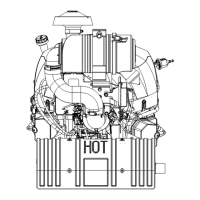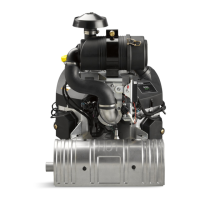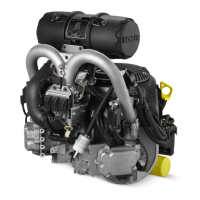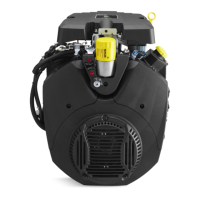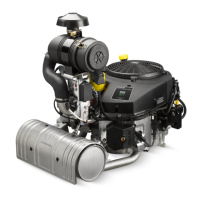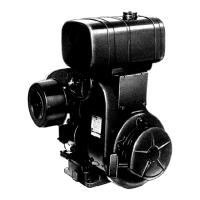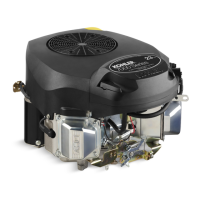11562 690 05 Rev. H KohlerEngines.com
Electrical System
4. Perform these output tests for charging system using
DVOM set to DC volts.
a. With engine off and key switch in OFF position,
measure voltage at battery. If less than 12.4 VDC,
recharge battery and retest. If 12.5 VDC continue
with tests.
b. Run engine at high speed no load (greater than
3000 RPM). After running 1 minute, measure
voltage at battery.
i. If voltage increases to between 13-15 VDC,
system is working correctly.
ii. If voltage increases to 15.5 VDC or higher,
system is overcharging. Replace rectifi er-
regulator.
iii. If voltage stays at 12.5 VDC or decreases,
charging system is NOT operating, proceed to
step 5.
5. With engine off , unplug rectifi er-regulator connector
and inspect connector terminals within connector
body and rectifi er-regulator terminals for corrosion/
arcing/damage. Repair/replace as needed. If OK,
proceed to next test.
6. Set DVOM to AC volts, place test leads to each
white stator wire. Run engine at 1200 RPM or
greater and monitor voltage.
Condition Conclusion
Voltage is 13 volts AC or
more.
Stator is OK.
Voltage is less than 13
volts AC.
Stator is faulty. Continue
with steps 7 and 8).
7. With engine off and stator unplugged from rectifi er-
regulator, check for resistance/continuity between
across stator leads (white wires).
Condition Conclusion
Resistance is 0.1/0.2
ohms.
Stator coil is OK.
Resistance is 0 ohms. Stator is shorted; replace.
Resistance is infi nity
ohms/no continuity.
Stator is open; replace.
8. With engine off and stator unplugged from rectifi er-
regulator, check for resistance/continuity from stator
leads (white wires) to ground.
Condition Conclusion
Resistance is infi nity ohms
(no continuity).
Stator is OK (not shorted
to ground).
Resistance (or continuity)
measured.
Stator leads are shorted to
ground; replace.
9. If stator tests good (steps 5-8), but system was
identifi ed in step 4 as not working, failure is likely
with rectifi er-regulator. Replace rectifi er-regulator,
retest system to confi rm repairs (step 4).
FUSES
This engine has 3 blade type automotive fuses.
Replacement fuses must have same rating as blown
fuse. Use fuse chart below to determine correct fuse.
Wire Color Fuse Rating
2 Purple Wires 30-amp Fuse
1 Red Wire w/ Black Stripe
1 Red Wire w/ White Stripe
10-amp Fuse
2 Red Wires 10-amp Fuse
Fuse Replacement
1. Shut engine off and remove key.
2. Locate fuse holders.
3. Remove fuse cover and pull out fuse. Inspect
condition of fuse holder.
4. Inspect fuse for a solid fusible link or a broken
fusible link. Replace fuse if fusible link is broken. If
you are not sure if fusible link is broken, replace
fuse.
5. Insert fuse into fuse holder until it is seated properly.
Install fuse cover.
6. If replacement fuse fails, there is a problem within
circuit. Diagnostics are required. Identify which
circuit is aff ected (see EFI System for electrical
schematic) by identifying failed fuse/circuit. Perform
troubleshooting procedures appropriate for circuit
fuse that failed.
7. Install fuse holder into fuse cover.
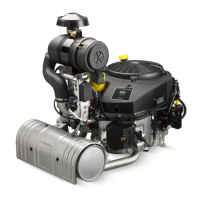
